Photo of the week - February 5, 2013
Marie Laveau's tomb at the Saint Louis Cemetery #1 in New Orleans. Fuji X-Pro1 with 35mm lens @ f/8. Processed with Snapseed (Mac version).
 Tuesday, February 5, 2013 |
Tuesday, February 5, 2013 |  Post a Comment in
Post a Comment in  photo of the week | tagged
photo of the week | tagged  35mm 1.4,
35mm 1.4,  cemetery,
cemetery,  fuji x-pro1,
fuji x-pro1,  new orleans
new orleans And then there were three...
Read more about this story here (and click on the images to embiggen).
Poaching in America
The other day I posted a video and commented on the illegal harvesting of rosewood in Madagascar. It looks like this sad disrespect for trees is happening closer to home as well. Sigh...
15 of 59 - The National Park checklist
With the addition of Pinnacles National Park in 2013, there are currently 59 National Parks in the United States; by my count I've visited at least 15* of them:
I really need to get out more...I'm barely at 25%! An Alaska trip would help knock a bunch of these out.
*It's also possible that as a kid I visited Crater Lake, Olympic, and Rocky Mountain. I don't specifically remember, but these are likely suspects for family roadtrip vacations.
Photo of the week - January 29, 2013

Murals in the Mission District of San Francisco. Fuji X-Pro1 with 35mm lens @ f/2. Processed with Snapseed on an iPad.
 Tuesday, January 29, 2013 |
Tuesday, January 29, 2013 |  Post a Comment in
Post a Comment in  photo of the week | tagged
photo of the week | tagged  35mm 1.4,
35mm 1.4,  california,
california,  fuji x-pro1
fuji x-pro1 Guitars, religion, evidence, and beliefs
 Beliefs about characteristics and generalizations of acoustic guitars, and their associated construction techniques and materials, seems to me to be a lot like religion. As an atheist this is weird for me to think about, but we (guitar players) make a lot of leaps of faith based on scant evidence (what we scientists call an "N of one"), what others have told us, and what makes "reasonable sense" to us as individuals. How much of what we believe, prefer, and hear in our instruments is based in tradition, expectations, superstition, illusory correlations, and what we read in books/magazines and on the internet?
Beliefs about characteristics and generalizations of acoustic guitars, and their associated construction techniques and materials, seems to me to be a lot like religion. As an atheist this is weird for me to think about, but we (guitar players) make a lot of leaps of faith based on scant evidence (what we scientists call an "N of one"), what others have told us, and what makes "reasonable sense" to us as individuals. How much of what we believe, prefer, and hear in our instruments is based in tradition, expectations, superstition, illusory correlations, and what we read in books/magazines and on the internet?
Another interesting parallel between acoustic guitar players and religion, although somewhat of a sidenote to this discussion, is that we are inherently conservative; it takes a long time to get us guitar players to change the standards of what is perceived as "normal" or preferable. For example, I'm really interested in seeing how the necessary future use of sustainable "alternatives" tonewoods is embraced by players/consumers. While I love the idea of walnut and cherry guitars that are made from timbers locally and responsibly harvested, given the choice, I'd still take my tried-and-true Honduran mahogany!
I really have great respect and envy for those few folks who have played hundreds and thousand of vintage and new guitars, and for those who build instruments (i.e., and do "experiments" to learn about acoustic properties of materials and construction techniques); those people with lots of data to base their beliefs on. Unfortunately, that's not me (yet?).
Keeping these reservations in mind, here are my guitar beliefs; much like religion, they are based on a small sample size, what people I respect think, and what "makes reasonable sense" given my basic knowledge of physics and lutherie. Some of these beliefs are probably totally irrational, and like religion, we could get into endless and unwinnable debates about all of these points:*
*However, unlike religion, the below points could all be tested experimentally,
and I'd happily change my mind in the face of good evidence.
- Lots of little things add up to a good sounding guitar. There are many "ingredients" that can be slightly changed, and these are the things that, in sum, create the unique tonal signatures of individual instruments and general characteristics of different acoustic guitar brands.
- I believe that hide glue positively impacts the sound of a guitar compared to titebond or other commonly used adhesives, which have more "flex" to them.
- I don't believe that, as a broad statement, lighter guitars sound better than heavier guitars (and I'm not talking about lightness of soundboard/bracing; that's another issue, and much less debatable). In terms if the thickness and stiffness of the sides/back of the instrument, I wonder if this impacts the projection of the sound outward versus feeling more vibrations as a player. I do, however, prefer the feeling of playing a light weight acoustic guitar, but that's probably more due to ergonomics.
 Bourgeois neck (from pantheonguitars.com)
Bourgeois neck (from pantheonguitars.com)

- Bolt-on vs. dovetailed necks: I believe that both can be excellent sounding, but that the type of neck joint probably does impact the tonal qualities of a guitar (although I can't say how). I like Collings (bolt-on) and I like Martin (dovetail). But bolt-on does add a bit a weight. I love, in principle, the design of bolt-on necks that don't glue the fingerboard to the top of the guitar (i.e., Taylor's NT neck and similar designs used by Bourgeois, my friend David Cavins, and like we did at the Vermont Instruments School of Lutherie) due to the relative ease of maintenance. I'm sure it colors the sound somehow, and it certainly does impact the overall weight of the instrument.
 Image source: fretnotguitarrepair.comWith the commercial success of Martin's "Authentic" series, which employs non-adjustable T-bar truss rods in many models (and non-adjustable ebony in others), there's been a renewed discussion in the relative merits of adjustable vs. non-adjustable truss rods. Like with neck joints, my guess is that there is a sonic difference, but this is one place I'd rather err on the side of modernity...I'll take adjustable over not if given the choice, especially if I'm buying a used guitar (like I tend to do).
Image source: fretnotguitarrepair.comWith the commercial success of Martin's "Authentic" series, which employs non-adjustable T-bar truss rods in many models (and non-adjustable ebony in others), there's been a renewed discussion in the relative merits of adjustable vs. non-adjustable truss rods. Like with neck joints, my guess is that there is a sonic difference, but this is one place I'd rather err on the side of modernity...I'll take adjustable over not if given the choice, especially if I'm buying a used guitar (like I tend to do).- I don't have enough personal experience with Brazilian rosewood to make statements about it's merits compared to Indian or other rosewoods. But I believe that the use of good Brazilian (i.e., quarter-sawn) is confounded with a lot of other variables that I do think are important (i.e., the use of hide glue, T-bar truss rods, age of the wood, and break-in time for vintage guitars). I'd love to spend some time with some guitar sporting various rosewoods that are otherwise as identical as possible.
- I do believe that herringbone purfling (or other similar decorative details around the top, like pearl inlay) could have a small impact on the sound, due to the wider channel being routed into the top right where it's connecting to the sides (maybe more flex = a bit more bass? just thinking theoretically, here).
 Herringbone Martin (image from folkwaysmusic.com...lots of nice guitars on their website!)
Herringbone Martin (image from folkwaysmusic.com...lots of nice guitars on their website!)
- I have heard a similar argument about sunburst tops: that the extra pigment that is applied to certain areas ever-so-slightly changes the mass of the top in those areas, which changes the sound. This seems far-fetched to me. In my opinion, if you do want to make the claim that sunbursts sound different/better (and I'm not a all convinced about this claim, although I love a good sunburst), what makes more sense is thinking about the stack of cosmetically "flawed" wood that could not be used if not for the shaded top...That there's lots of great sounding wood to choose from if you ignore cosmetics, and sunbursts allow luthiers to pick tops based on tonal properties only without having to balance the look of the top in their selection.
- I think there is probably significant overlap in the distribution of Sitka vs. Adirondack tops (i.e., normal curves that overlap), but that there are some characteristic differences between them on average. But that "different" does not globally mean "better."
- I suspect that the labels of "European," "German," "Italian" etc. spruce that are used are not particularly useful, because they refer to where the wood came from, not a particular species. That's not to say they don't sound and look different that your typical Sitka top, but that it's not so clear, across makers, what the consistent tonal properties of these woods are.
- In theory I like idea of Madagascar rosewood as an alternative to Brazilian, but I'm uncomfortable with it due to the socio-political and environmental concerns associated with its harvest (more about this topic here and here). For my own piece of mind, along with all the reasons to buy vintage, if I wanted a rosewood guitar, I'd pony up the dough and get a '50s-era D-28 or '45-55 000-21 or 000-28, and not one of the re-issues or custom models that many manufactures have rolled out recently.
- That wood, as a material that is/was alive, continues to change both due to aging and playing (i.e., the "opening up" that players described is a function of at least two processes that impact the structure of the wood itself).
- Related to the above point: I believe that part, but not all, of the "opening up" process is psychological-- that we become more familiar with the sound of a guitar over time, and that is perceived as more pleasing. Yes, remember that I'm a social psychologist, and that we call this the "mere exposure effect."
- One of my biggest "turn-offs" are the pixelated pickguards that Martin used (still uses?) on some of their guitars, like my 2002 D-18GE. I've since replaced mine with a "tor-tis" Dalmatian pickguard, which is admittedly a non-traditional choice for an -18-style guitar.
![]() Ick! (from http://www.acousticguitarforum.com/forums/showthread.php?t=266220)
Ick! (from http://www.acousticguitarforum.com/forums/showthread.php?t=266220)
Photo of the week - January 22, 2013

At the El Sur Ranch (Highway 1, side of the road). Fuji X-Pro1 with 60mm lens @ f/2.8, processed with Snapseed on a iPad.
 Tuesday, January 22, 2013 |
Tuesday, January 22, 2013 |  Post a Comment in
Post a Comment in  photo of the week | tagged
photo of the week | tagged  60mm macro,
60mm macro,  california,
california,  fuji x-pro1
fuji x-pro1 "He strummed his way into TROUBLE"
I ran across this print, by artist Spencer Kimball, at Dos Coyotes in Davis the other day. This would look good in my home office, hint hint.

The beard illusion
I usually wouldn't be so keen on posting advertisements on my site, but these images were interesting to me, both as a photographer and beard enthusiast. See more info on these pictures here.

Photo of the week - January 8, 2013

At the Monterey Bay Aquarium. Fuji X-Pro1 with 35mm lens @ f/1.4, processed with Snapseed on an iPad.
 Tuesday, January 8, 2013 |
Tuesday, January 8, 2013 |  Post a Comment in
Post a Comment in  photo of the week | tagged
photo of the week | tagged  35mm 1.4,
35mm 1.4,  california,
california,  fuji x-pro1
fuji x-pro1 Guitar history - Graduate school
Last time I chronicled the guitars I started with through college. All of those are long gone, as are most that were acquired during graduate school (1996-2001). But this was an important time; along with furthering my education in psychology, this is really when I started to learn about what to look for in a good guitar and what I tend to like (e.g., mahogany). Student loans really helped with this part of my education! The fact that West Lafayette didn't have a good Martin dealer (and had an excellent Taylor dealer) very much shaped this stage.
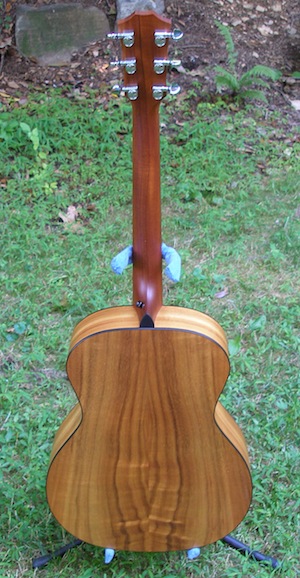 Taylor 414K from 1997.Taylor 420R (1997; serial #970604026) - This came from Klaverenga Guitar & Piano in West Lafayette, where I first heard of Taylor. Sitka and rosewood. Sold it in 2001. Reflecting back on my progression through guitars, my feeling now is that Taylors are a great entry to acoustic guitars...They are very "sweet" sounding and accessible. As I got older I started to gravitate towards more complex-sounding guitars, but for me, it was a great way to get hooked on the acoustic guitar.
Taylor 414K from 1997.Taylor 420R (1997; serial #970604026) - This came from Klaverenga Guitar & Piano in West Lafayette, where I first heard of Taylor. Sitka and rosewood. Sold it in 2001. Reflecting back on my progression through guitars, my feeling now is that Taylors are a great entry to acoustic guitars...They are very "sweet" sounding and accessible. As I got older I started to gravitate towards more complex-sounding guitars, but for me, it was a great way to get hooked on the acoustic guitar.- Taylor 414K (1997; serial #971030018) - A koa grand auditorium, limited from 1997. This is when I realized that there were other sized guitars than jumbos and dreadnoughts, and that I prefer 1-3/4" necks to 1-11/16". This one stayed around until 2006, give or take a couple of years, when I sold it on Craigslist.
- Larrivée LS-05 (1995; serial #16903) - I used money from my first teaching gig to get this at Front Porch Music in Valparaiso, Indiana, in 1998. A nifty little classical-inspired steel-string guitar; ended up selling this at the Philly guitar show in 2005 or so.
- Taylor 355 (1998; serial #9808xxxxx) - For some reason, I can't seem to be without a 12-string guitar, although admittedly, I rarely play it these days. I've been tempted to sell it, but I suspect I'd find myself wanting another 12 again in the future. This seems like a good one to keep around; a quality instrument, but without too much invested in it. Like the other Taylors, this one came from Klaverenga.
- Tacoma Papoose P1 (1997; serial #5012) - A neat high-strung instrument with a factory-installed pickup. Bought in West Lafayette in 1999; sold on-line in 2006.
- Taylor Baby - Mahogany top (1998; serial #981124xxx-x) - Thought I needed a travel guitar. Other than a couple of trips, this one has pretty much sat in its case.
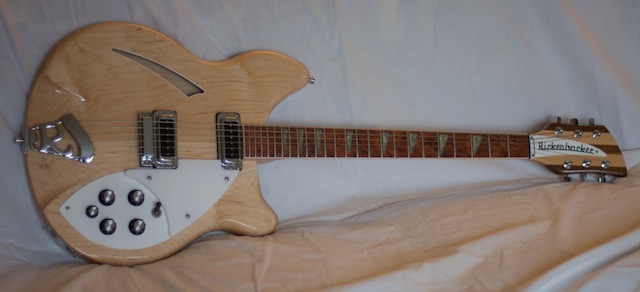 Rickenbacker 360.
Rickenbacker 360.
- Rickenbacker 360 mapleglo (1999; serial #9929827) - I had wanted one of these for a long time. I had a picture of a blonde Rickenbacker 381 pinned to my wall in my dorm room at Grinnell, and when I got the Taylors my Guild seemed expendable, so I took a road trip to Elderly Music and traded it towards the 360. A beautiful guitar, although it made me realize a couple of things. First, I prefer larger necks, and the 1-5/8" neck was pretty small; second, I don't really play electric much. So I sold it (and actually made a bit of money) on Craigslist in 2010 or so. Used the money to buy an 85mm f/1.4D Nikon lens.
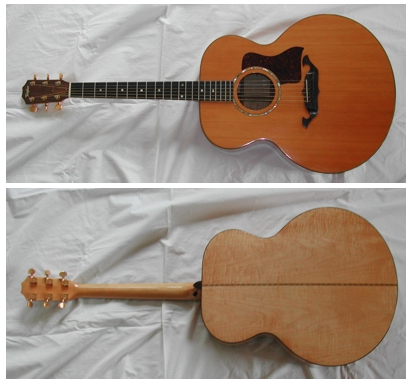 1977 Taylor 915.Taylor 915 (1977; serial #37x....last digit missing due to a torn label when the neck was reset) - My first internet guitar purchase; I got this from a fellow in New Jersey in 1999...One of the first 400 guitars Taylor ever built...A maple jumbo with an uber-cool moustache bridge. Sold this on Craigslist in 2008 or so.
1977 Taylor 915.Taylor 915 (1977; serial #37x....last digit missing due to a torn label when the neck was reset) - My first internet guitar purchase; I got this from a fellow in New Jersey in 1999...One of the first 400 guitars Taylor ever built...A maple jumbo with an uber-cool moustache bridge. Sold this on Craigslist in 2008 or so.- Larrivée Parlor Koa prototype (2000; serial #34226) - A limited run of parlors built in other woods (besides mahogany) for the NAMM show. Bought from Buffalo Brothers; sold on ebay in 2006 (and made some money on it!). A cool little guitar.
Photo of the week - January 1, 2013

At Rodeo Beach on the Marin Headlands. Nikon D3100 with 18-105mm lens, processed with Snapseed on an iPad.
 Tuesday, January 1, 2013 |
Tuesday, January 1, 2013 |  Post a Comment in
Post a Comment in  photo of the week | tagged
photo of the week | tagged  18-105mm,
18-105mm,  california,
california,  nikon d3100
nikon d3100 Guitar history - High school and college
I've been meaning to do a log of the guitars I've owned across the last 20+ years. This is a pretty daunting task if I try to tackle it all in one big list, so I'll break it up into chunks. To get the ball rolling, I'll start with high school and college (Cal Poly and Grinnell), which goes up to summer of 1996; later editions will cover other eras (split by academic markers: grad school, pre-tenure, post-tenure).
- Fender Gemini II (mid-to-late-80s, I assume) - My first steel-string acoustic. I got this for Christmas in 1990 (I think...maybe the year before that?). Bought used from the music shop in Davis, CA. Sold it to a guy in the dorms at Cal Poly when I got the Landola jumbo (see below) in 1993.
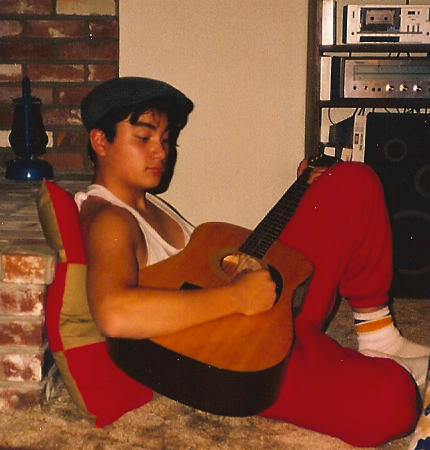 Bad circa 1990 fashion with the Gemini II.
Bad circa 1990 fashion with the Gemini II.
- Fender Stratocaster (Lake Placid blue, maple neck, MIM, early-90s) - Christmas 1992; bought used at a (now forgotten) shop in San Luis Obispo. Consigned it at some point in graduate school in West Lafayette.
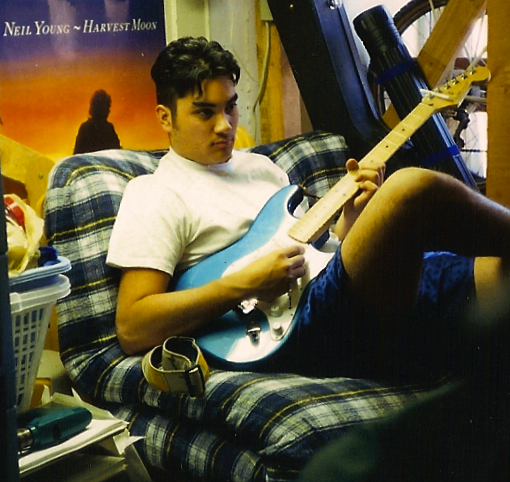
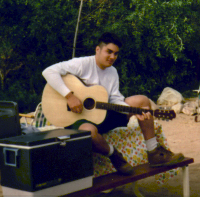 With the Landola jumbo, summer 1993.Landola jumbo...I don't remember the model number (early-90s) - Purchased new in spring 1993 at some shop in San Luis Obispo, Los Osos, or Morro Bay. I'm shocked how bad my memory is! An interesting jumbo guitar, made in Finland, with a solid spruce top and laminated birch back/sides, and matte finish. Landola went on to make a run of acoustic guitars for Peavey (the amp company). Sold it in West Lafayette. Never saw another Landola until the fall 2012 Philly guitar show, where I ran into a similar one. A nice guitar.
With the Landola jumbo, summer 1993.Landola jumbo...I don't remember the model number (early-90s) - Purchased new in spring 1993 at some shop in San Luis Obispo, Los Osos, or Morro Bay. I'm shocked how bad my memory is! An interesting jumbo guitar, made in Finland, with a solid spruce top and laminated birch back/sides, and matte finish. Landola went on to make a run of acoustic guitars for Peavey (the amp company). Sold it in West Lafayette. Never saw another Landola until the fall 2012 Philly guitar show, where I ran into a similar one. A nice guitar.- Cheap-o Aspen 12-string (unknown year) - I don't recall where this one came from. I assume I bought it off someone at Grinnell; $40 rings a bell. The bridge started to pull off and had it reglued by a guy in Marshalltown at least once. We ended up playing this as a six-string to keep the bridge from flying off; I think I handed this down to Wulfy.
- Takamine N-1012 (early-90s) - My first decent 12-string; this one came used from the Guitar Foundation in Iowa City in late-1994 or early-1995...Solid cedar top with (laminated) mahogany back/sides. My buddy Dave and I played this one a lot; I had it until 1997 or 1998, when I sold it West Lafayette.
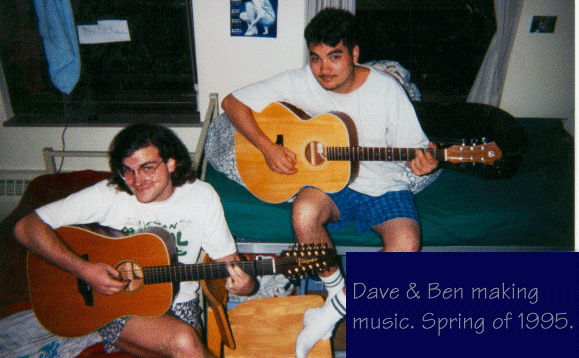 Dave with the Takamine N-1012 and Ben with the Landola jumbo.
Dave with the Takamine N-1012 and Ben with the Landola jumbo.
- Guild 12-string (can't recall the model or year, although I'm pretty sure it was a jumbo or mini-jumbo from the '70s...maybe a 212XL?) - If I recall correctly, I got this at Ye Olde Guitar Shoppe in Des Moines. What I remember more about YOGS is that's where I saw my first Martin...I remember that vividly: a 1989 D-16A (ash); that Martin was probably around $800, but it seemed like a million bucks. But I'm thankful for running in to it, as it put Martin on my radar screen. I think that Guild had some (neck?) issues, and I have no recollection what happened to it. I assume I sold it when I got the Guild D-40SB. I wish I would have paid more attention to this guitar; it was probably pretty nice!
- Martin Backpacker (1995; serial #23,058) - This came from a shop in downtown Santa Rosa...I remember buying it when I was home for winter break in 1995. Sold it on craigslist once I moved to Pennsylvania (maybe 2005 or so?).
- Guild D-40SB (1976; serial #158276) - My first venture into quality solid-wood American guitars; this likely started my affinity for sunburst guitars. I found it at the music shop in Grinnell for $500, which was a fortune for a college student in 1996. I maxed-out my credit card to buy it. A nice guitar...Build like a tank with a sweet sound, although it wasn't that loud. I traded this one at Elderly Music in Lansing towards the Rickenbacker 360 (to be described in the next edition).
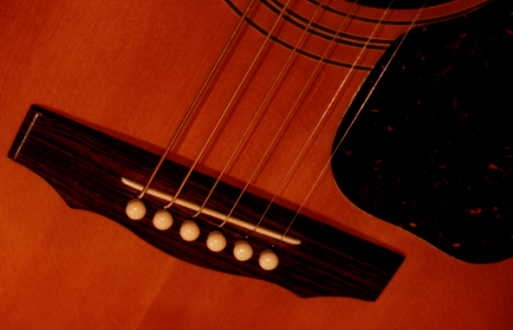 The only picture I could find of the Guild D-40SB.
The only picture I could find of the Guild D-40SB.
Next up...Student loans in grad school = the start of guitar collecting.
Martin guitars and I/O psychology
A nice discussion of the organizational culture at the Martin Guitar Company. Other organizations I've been involved in could learn a lot from Martin ("we treat all coworkers with dignity and respect"). I always love it when the psychology and guitar worlds collide.
On blogging
I ran across this cartoon from thedoghousediaries.com and it struck a chord with me. Creating content for a blog is a lot of work; I made a snide comment about my site turning into a tumblr page the other day, and there's some truth to it given that I've been posting a lot of videos that I've run across here (half of this is for me, so I can watch them again). I have created a good deal of content on ScienceOfRelationships.com, and I try to post my photos when I can, but my hats off to those who can generate regular interesting and cohesive content for the interwebs.
Guitar history - Childhood
I've been working on a personal history of the guitars I've owned (update: see here for Part 1). As a prelude to that series, here are a couple of pictures from my childhood. When my parents say I spend too much money on guitars, they only have themselves to blame.
 Toronto, 1975.
Toronto, 1975.
 My dad's birthday, probably 1980 or 1981.
My dad's birthday, probably 1980 or 1981.
Although you wouldn't know it by these pictures, I stupidly rejected learning how to play guitar as a child and didn't become interested in the instrument until I was 15 or so. I remember taking a class when I was about 5 or 6 in Davis, becoming increasingly frustrated with having to learn "Hot Crossed Buns." If they would have showed me some Hendrix or Tony Rice right from the get-go, maybe I would have stuck with it (and by "showed" I don't mean teaching a 5-year old how to play "Voodoo Chile"...I mean showing that there was someplace it could go beyond dumb kid's songs). I took lessons briefly in high school and then for a semester in college from Roger Lasley, who was the registrar at Grinnell at the time. Having just started guitar lessons again last week, I'm regretting not being more serious about playing as a child/teen.
Ryan Adams + Cindy Cashdollar = Awesome
As much as I like Ryan Adams, this video is making me want to play the dobro.
Kathleen Edwards + Vintage Gibsons
This really isn't helping my GAS for an early-50's J-45 or J-50.
GIFs are cool in 2012
.gifs are supposedly "in" in 2012, and at the risk of turning my blog into a tumblr page, here's one of my favorites from Edward Gorey's The Gashlycrumb Tinies.







